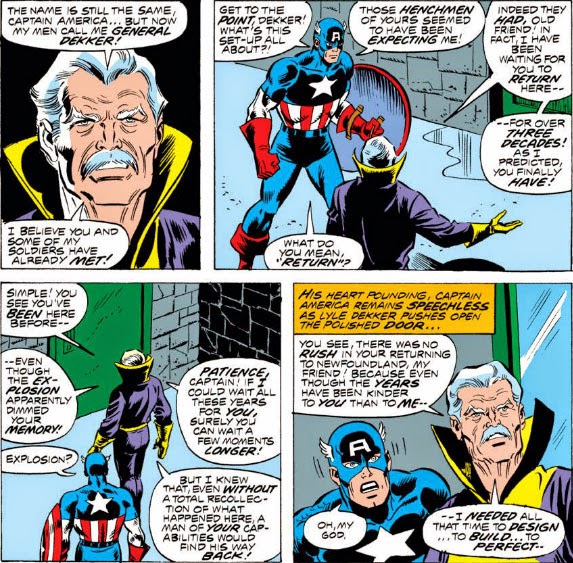If you were reading comics in mid- to late-1978, you probably remember seeing a few double-page sweepstakes offers from Beatrice Foods, which at the time held candy products such as the Clark Bar, Milk Duds, Zagnut, et al. The ads were placed directly at the mid-point of the comic you were reading, and featured a large graphic of either one or a group of Marvel characters (I'm assuming DC comics also had ads with their own characters featured), surrounded by the terms of the sweepstakes.
Two of these ads may have seemed formatted much the same to you, with those large, striking bold captions heading each one. Yes, they were from the same company, only with different ads for basically the same sweeps, spaced a few months apart:
If you were like me, the last thing you wanted to do was to interrupt the story you were reading and machete your way through this kind of promotional material; so chances are you flipped the page, and by the time you'd finished the story, the sweepstakes ad had already been forgotten. Still, free money and prizes were being offered (legitimately, it seemed), and so I feel it's my duty to let you know what we passed on at the time. For what it's worth, we probably don't even remember what story we found so much more interesting than these ads--how's
that for karma.
With these ads, the devil indeed seems to be in the details. For instance, entry into the Milk Duds sweeps automatically entered you into the Clark Bar sweeps--but not vice versa (at least not according to the copy). Also, there was no Grand Prize in the Clark Bar sweeps, as there was in the Milk Duds ad. There are one or two other discrepancies between the two sweeps, but offhand I'd say the Milk Duds sweepstakes was the better choice.
So, briefly, here are the winnings:
First Prize:
- Round-trip flight to NYC, + all-expense-paid lodging for 3 days and 2 nights (limit family of 4)
- Personal tour of Marvel Comics offices; artist will draw your image, to be inserted into an upcoming issue of your favorite Marvel comic (includes 15 free copies of the comic)
Second Prize (20 winners):
Choice of Superhero or Superduds full-color Swiss-made wrist watch
Third Prize (100 winners):
1-year subscription to a DC or Marvel comic of your choice
All sweeps entrants entered into the
Grand Prize drawing (10 winners):
A 10-speed Schwinn bicycle
All in all, not a bad contest to take the time to mail an entry form and enclose a candy wrapper. That First Prize sounds pretty sweet, especially if you'd never seen NYC before--and the only money you shell out is for sightseeing, souvenirs, plays, or other diversions. (Let's assume that meals were covered if you dined at the hotel--assuming there were dining facilities wherever they put you up.)
And speaking of contests, let's jump to 1980 and see what Marvel itself cooked up when it threw its hat into the contest ring. Remember when this banner appeared on comics covers at the time and effectively shrunk the cover's art to accommodate it?
The "Win-Yourself-Some-Big-Bucks Contest" was a kinda-sorta sweepstakes--except that you had to work a little harder to enter, and prize recipients weren't determined by random drawings. Boiled down, it's a Marvel survey; but instead of checking off boxes, you give your answers in written form.
Entrants are split into age groups, with each group having its own question to answer:
Ages 10 and under:
Who is your favorite Marvel super hero, and why? (25 words or less)
Ages 11-14:
Who is your least favorite Marvel character, and what can we do to improve him or her? (25 words or less)
Ages 15 and older :
How should the Marvel Universe change to face the challenges of the eighties? (50 words or less)
As for the prizes, there's no all-expense-paid trip, but they're still pretty decent:
First Prize: $2,500
Second Prize: $1,000
Third Prize: $500
Fourth Prize (100 winners): A copy of
Origins of Marvel Comics, autographed by Stan Lee
Fifth Prize (250 winners): 1-year subscription to a Marvel comic of your choice
You could enter as often as you wish, but each entry must be accompanied by a proof-of-purchase stamp (i.e., you'd have to buy a comic each time you wanted to enter). The winners were selected by Marden-Kane, Inc., an independent judging firm, based on "originality, aptness of thought, sincerity, and neatness."
At the top of the contest ad, Editor-In-Chief Jim Shooter has a conspicuous note about prices going up for Marvel books, with the contest being offered as a thanks-for-your-understanding gesture. And you have to hope entrants who were late to this party were pretty generous with their understanding, given that the ad pictured here appeared in a comic dated September, 1980, while the contest terms specify that "all entries must be received by August 15, 1980 to be eligible."
(I was wondering why the Hulk was looking puzzled.)

















































